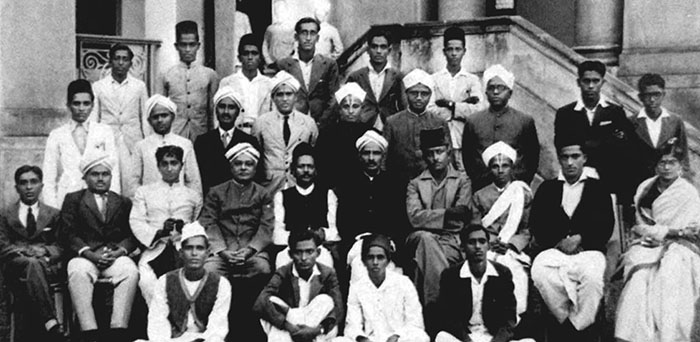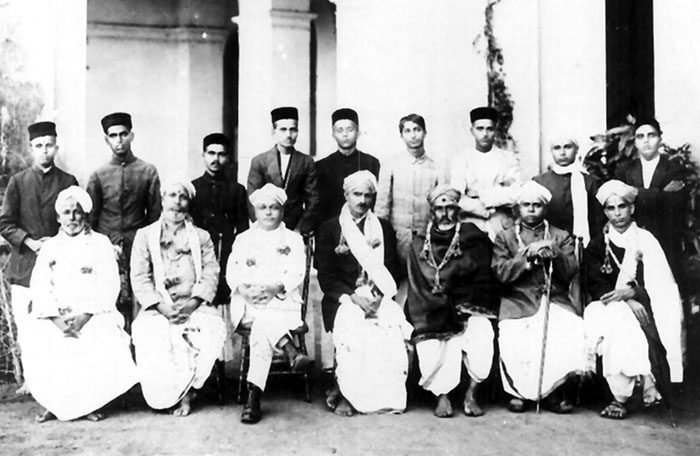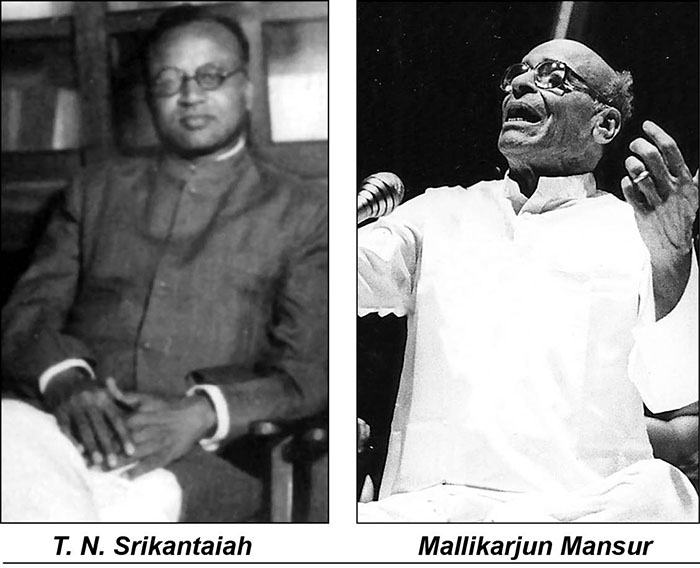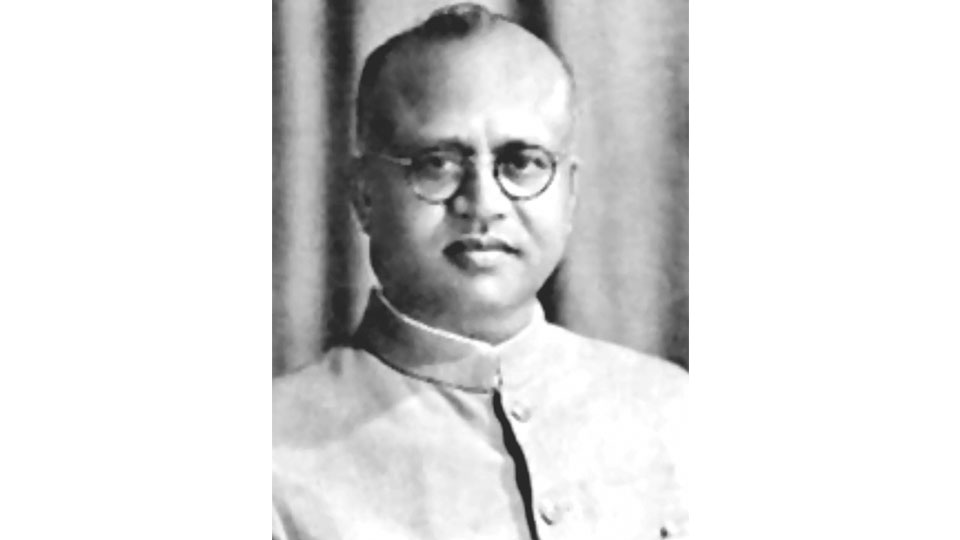Ti. Nam. Shri, a grammarian par excellence
T. N. Srikantaiah, known endearingly to a generation of readers as Ti. Nam. Shri, was a Kannada poet, writer, translator, teacher and grammarian par excellence. Groomed under the able guidance of M. Hiriyanna and B.M. Srikantaiah, he in turn would nurture and guide such scholars as S. Ananthanarayan and M. Chidanandamurthy. Srikantaiah’s magnum opus “Bharatheeya Kavyamimamse” remains to this day a most revered and respected work on poetics, linguistics and history of poetry across centuries. Srikantaiah was also the person responsible for coining the term ‘Rashtrapathi’ as a suitable vernacular equivalent for the ‘President’ of India — a usage that has been adopted into practice ever since! This biographical piece is a small tribute to this legend.—Ed
By Dr. Bhagirath S. Naganath
Theerthapura Nanjundaiah Srikantaiah (Kan: Ti. Nam. Shri) was born on 26th November, 1906 in Theerthapura village, Tumkur district. His father was Shanbog Nanjundaiah and mother Baluvaneeralina Bhagirathamma.
He lost his mother at the tender age of 9 and was raised by his aunts on either side of the family. These women tried to fill the void left behind by his mother. This probably contributed to his affectionate demeanour and caring attitude towards womenfolk all through his life. This trait comes to the fore in many of his later works such as Hennu Makkala Padagalu, Essays on Attimabbe, Keregehara and Mahadeviyakkana Kelavu Vachanagalu.
Early years
T.N. Srikantaiah had his schooling at Theerthapura, where he passed his lower secondary exam in 1916. His middle school education was completed at Chikkanayakanahalli after which he joined the Tumkur Government Collegiate high school in 1919 for his high school education.
In his home town, a gentleman by name Bhyrappa had established a small circulating library at his house. He was affiliated to the Agricultural Training School. In this circulating library, Srikantaiah stumbled across periodicals like Krishnasukti, Sadboha Chandrika, Madhuravani and some translations by Bindiganaville Venkatachar and Galaganatha. Srikantaiah had memorised many passages of Kalidasa’s Raghuvamsha in his Sanskrit classes.
Much to his father’s displeasure, he had chosen Kannada as his second language. However, most of his early contributions to the school magazine were essentially in Kannada.
He was an avid contributor to the school newspaper School Folk. Among his earliest articles was an English article titled My Mother. This article was well-received by his teachers and peers. Another moving piece in memory of his childhood friend who had succumbed to the plague was titled Mitramilapam. Among his first poems, Shokageethe in Kannada was an early testament towards his grasp of metre and scale.
T. N. Srikantaiah completed his BA degree in 1926 and stood first in his class. At the convocation, he received six gold medals from Nalwadi Krishna Raja Wadiyar. As MA in Kannada was not yet available, he pursued his M. A. in English. In 1928, he gave his M.C.S. exam where he stood third in the civil service rankings. This helped him get a probationer’s post in the Revenue Department at Srirangapatna. Two months later, he was appointed as Lecturer at the Intermediate College, Mysore. Srikantaiah readily accepted this appointment thereby relinquishing his position in the Revenue Department. His grandfather was dismayed that his grandson had quit a secure Government job at the Tax Office for a teacher’s job!
He completed his MA in 1929 and got the first rank. Following this, he was transfe-rred to Maharaja College, Mysore. Around this time, B.M. Srikantaiah started MA in Kannada at Mysore. This prompted T.N. Srikantaiah to sit for Kannada MA exam as well. He passed this exam in flying colours by securing first rank! He was awarded three gold medals at the convocation in 1931.

Academician
A.N. Murthy Rao’s essay Maharaja College’s Common Room describes the arrival of ten young lecturers to Maharaja College who would eventually change the intellectual landscape of the establishment. T. N. Srikantaiah features prominently among them. Though T.N. Srikantaiah had a MA both in Kannada and English, it was thanks to B.M. Srikantaiah and T. S. Venkannayya, that he chose to remain with Kannada rather than English.
By 1943, Srikantaiah was promoted to the post of Associate Professor and was transferred to Bangalore. At Bangalore, he became associated with Prof. A.N. Murthy Rao, Pu. Ti. Narasimhachar, Maasti Venkatesh Iyengar and even worked with A.R. Krishnashastry on Kannada Dictionary Project.
Between 1948 and 1950, he worked as Chief Translator at the Mysore Samvidhana Parishat. Srikantaiah also taught in Davanagere Government College during these years. From 1951 onwards, for a few months, he was appointed as Superintendent at a College in Kolar.
By 1952, he was invited to Dharwad Karnatak University as the University’s first Kannada Professor. Here he was instrumental in laying down the foundation for the nascent Kannada Department. His brief tenure here brought him in close contact with Pune’s Deccan College as well.
He was made a Visiting Professor at the Deccan College and was involved in arranging classes on linguistics, especially during the vacation period. Eminent linguists of the time such as Dr. Suneeth Kumar Chatterjee and Dr. M.B. Emono (then Vice-Chancellor of California University) were in constant communication with T.N. Srikantaiah during this period. The next year, that is 1952, saw Srikantaiah bring forth his seminal work — a Kannada version of the newly formulated Constitution of India!
By 1955, T.N. Srikantaiah received a Rockefeller Scholar-ship for a brief educational tour of the United States. For eight months, from 1955-56, Srikantaiah spent his time doing research at Michigan, Pennsylvania. Following this, he spent a month in UK, then France, Italy and few other European countries. Even though the Rockefeller Scholarship entitled T. N. Srikantaiah to bring his wife along, he declined the offer owing to family commitments!
He returned to Maharaja College, Mysore, in 1957. Kuvempu had just relinquished his post as Principal and had become the Vice-Chancellor of University of Mysore.
T.N. Srikantaiah’s first book Olume was published in 1932. In all, he published fourteen works, three of these being printed posthumously. His works, though few in number, were always well received by his fellow litterateurs and the reading public.
Regarding his first published work Olume, Masti Venkatesh Iyengar remarked in his review in Prabhuddha Karnataka that this anthology filled a long-awaited void in the Kannada literary landscape and that there ought to be a bigger successor to this one!
Similarly, his Rakshasana Mudrike based on Vishakadatta’s Sanskrit play Mudrarakshasa, written at the suggestion of T.S. Venkannayya was well-received by critics. His book Gadayuddha Sangraham ran to 92 pages, with footnotes and summary running to an additional 116 pages! It was dedicated to his guru B.M. Srikantaiah on the 1000-year anniversary of the Kannada poet Ranna in 1949. Collection of his lectures at AIR was brought out as Kavyanubhava in 1970, four years after his demise.
Bharatheeya Kavyamim-amse: This is considered by many to be T.N. Srikantaiah’s magnum opus. Inspired by B.M. Srikantaiah and guided by M. Hiriyanna, Srikantaiah could not have desired for better guidance than these two titans. Hiriyanna, who had retired by this time, decided to take up the task of tutoring Anandavardhana’s ‘Dhvanyaloka’ to Srikantaiah. On more than one occasion, Srikantaiah later recollected this as a once in a lifetime experience!
Hiriyanna furthermore agreed to go through the first draft of Srikantaiah’s Bharatheeya Kavyamimamse, offering his precious insights into it. This work ran to 475 pages and charted the history and tradition of Indian Poetics across vast timelines. In fact, the scope of this work was so vast that D.L. Narasimhachar remarked that: ‘No Indian language can lay claim to a book that can remotely equal this magnificent edifice!’
Sadly enough, Srikantaiah was greatly disheartened at the quality of the publication process and was deeply disturbed at the plethora of mistakes that had crept into the final edition! Adding insult to injury, this towering work scarcely got the due recognition it deserved. After the institution of the Pampa Prashasthi, this book became the second one to receive the prestigious award (first one being Kuvempu’s Ramayana Darshanam). While the award was a welcome recognition, the fact that it came 36 years after the book got published was a disappointment that could scarcely be concealed.
T.N. Srikantaiah’s treatise on Kavyamimamse remains his most respected and revered work. He was always active in many Kannada Sanghas in the old Mysore region and was an avid advocate for the cause of Kannada language. By 1935, he had penned eight English essays and ten Kannada essays. His Kannada Madhyama Vyakarana was a standard book for teaching Kannada grammar. Between 1958-61, M.R. Ranganath under the guidance of T. N. Srikantaiah brought forth a 350-page seminal work on Kannada Grammar and Linguistics titled Morphophonemic Analysis of the Kannada Language. This was published by The Centre for Indian Languages, Mysore, in 1982 and covered over 96,000 Kannada words!
T. N. Srikantaiah would inspire and guide works of similar stature from other budding litterateurs of his day. S. Anantanarayan’s Hosagannadada Sahityada Mele Paschatya Kavyada Prabhava (Influences of western poe-try on modern Kannada wri-ting) was completed under Srikantaiah’s guidance. It was a matter of some regret that this comprehensive work was denied a Doctorate due to petty departmental politics.
Similarly, M. Chidananda-murthy’s Kannada Shasanagala Samskruthika Adhyayana (Cultural Study of Kannada Epigraphical Records) was also done at T.N. Srikantaiah’s behest. When this work was eventually accorded a Doctorate degree, Srikantaiah is said to have remarked that ‘he was no longer barren (implying that he had at long last produced an offspring)’! Reading Chidanandamurthy’s doctoral work, D.L. Narasimhachar later exclaimed thus — ‘A Thesis is meant to be written this way!’
In the Indian Constitutional Committee meeting in 1949, it was T.N. Srikantaiah who suggested the word ‘Rashtrapathi’ as the apt nomenclature for the President. This was readily welcomed and adopted into practice.
In 1943, he presided over the ‘Sahitya Sammelana Bhasha Bandavya Ghosti’. In 1957, he was invited to chair the ‘Dravida Samskruthi Ghosti’. In 1958, he was appointed as Secretary for local chapter of Summer School of Linguistics at Mysore. In 1960, he was appointed as Secretary of the All India Linguists’ Association.
T. N. Srikantaiah took an active role in the Kannada dictionary project. Around this time, the Post Graduate Department at Manasagangothri campus was taking shape. Srikantaiah was instrumental in laying the foundation for the Kannada Department there.
Srikantaiah retired in March 1962 after 34 years of service. Following his retirement, he returned to the department as a UGC Professor and would eventually head the Kannada Dictionary Project as its Secretary. By 1965, T. N. Srikantaiah received an invitation from Delhi University to join the Linguistics Department as an adjunct Professor. He had to decline this as he was already preoccupied with many ongoing projects in the Kannada Department.

Personal Life
T.N. Srikantaiah married Jayalakshmi in 1929. The couple had their first child Vishalakshi in 1931. Second daughter Nagarathna was born in 1936. His son Nagabhushana was born in 1942. Sadly, Srikantaiah had two still born sons before these. His eldest daughter Vishalakshi passed away in 1943 at the age of 12 years! Srikantaiah also supported his sister Savitramma.
His daughter Nagarathna’s wedding materialised in 1961. After nearly four decades of academic service, Srikantaiah finally managed to secure a house of his own through CITB in 1962! He conducted his son’s Upanayana in 1963. That same year, Srikantaiah had a granddaughter as well.
In August 1961, Srikantaiah was invited to a Conference of Technical Linguists, arranged under the aegis of the Education Department in New Delhi. He took his wife along and planned trips to Agra and few other places in North India. From here the couple made their way to Ranchi where they met their daughter and son-in-law. T. N. Srikantaiah has noted in jest that this tour of North India was a long-awaited honeymoon trip for him and his wife, albeit 40 years late! Srikantaiah’s son was a student at Calcutta around this time.
In Calcutta, T.N. Srikantaiah succumbed to a heart attack on 7th September, 1966 at the age of 59 years. His funeral took place in Calcutta.

Legacy
Srikantaiah was fond of recollecting many verses from Victorian poets. His personal favourite was a poem by Robert Browning titled A Grammarian’s Funeral. Much of Srikantaiah’s literary output happened prior to his 45th year of life. It has been often lamented that Srikantaiah’s literary output fell well short of his vast intellect and repertoire of knowledge. Probably, successive transfers from place to place and the travails of family life were to be blamed for this. A number of manuscripts and some notes on Kavyamimamse still remain unpublished. His lifelong dedication to the field of Kannada linguistics and lexicography never showed any sign of slowing down. His most popular anecdote about this vast field was, ‘Language is poetry, linguistics is poetics’!
It was almost commonplace for students of different classes to come and sit in T.N. Srikantaiah’s class — especially those dealing with Metre (Chandassu), Kavyamimamse and Linguistics.
Srikantaiah’s oratorical skills were well known. Once, there was an all-night festival arranged on the banks of river Annigeri from nine in the night till three in the morning. This was on the occasion of Purandara Dasa Jayanti. Srikantaiah delivered an impressive talk at length. After his talk, Mallikarjun Mansur graced the stage and showing his hand towards Srikantaiah began his performance with the vachana — Nudidare Mutthina Haradanthirabeku!
In 1957, the Maharaja College English Literary Association had arranged their annual function and had invited T. N. Srikantaiah to deliver a lecture titled The Poetic World. At the end of the lecture, the English faculty crossed over the aisle to shake hands with their Kannada colleagues and congratulated them on having such a knowledgeable and eloquent speaker amidst them!
In 1958, Maharaja College Kannada Sangha had arranged their annual function and Srikantaiah delivered a lecture on Kannadada Abhyasa. D.L. Narasimhachar, moved by Srikantaiah’s oratory, remarked that this lecture ought to be broadcast to the four corners of Karnataka!
Considering his vast repertoire of knowledge and remarkable oratory, the volume of literary work that he produced during four decades was considerably on the lower side. A.N. Murthy Rao was particularly vocal in his observations in this regard. Srikantaiah in response is said to have remarked in chaste Kannada, Odu Barahakke Shatru! (Serious study hinders creative writing!). To which the other doyen of Kannada poetry P. T. Narasimhachar whimsically added Maathu Kooda Barahakke Shatru! (Even conversation can be an impediment to writing!).
However, in life, there were many impediments that were beyond his control. Each of his books took an inordinate amount of time getting published. Apathy and a palpable lack of initiative on part of the University was often to blame. His ‘Rakshasana Mudrike’ completed in 1931 got published eleven years later in 1942! His ‘Bharatheeya Kavyamimamse’ completed in 1940 got published thirteen years later in 1953! Three of his remaining works were never published during his lifetime and saw the light of day many years after his passing!
Surely, delays of such nature would have discouraged the most optimistic among us. When someone asked him about these delays and his thoughts there of, he rather cryptically quipped what his guru Hiriyanna had once told him — Bharatheeya Tattvagnanavendare Adondu Jeevana Vidhana! (The Essence of Indian Philosophy is that it is essentially a way of life). Adhering to Hiriyanna’s values, T.N. Srikantaiah readily side stepped, when he was approached to preside over the Kannada Sahitya Sammelana, excusing himself on the grounds that there were far more erudite senior scholars than him for that position!
Generations of Kannada students, reading public and academicians alike remember T.N. Srikantaiah with great revere-nce, not just for his endearing contribution to Kannada, but also as the gentle affable soul that he was during his lifetime.
[References: 1. ‘Srikantatheertha’ (T.N. Srikantaiah Commemoration Volume); 2. ‘Ti Nam Shri’ by D. Javaregowda; 3. ‘Samagra Lalitha Prabandagalu’ by A.N. Murthy Rao; 4. ‘B.M. Srikantaiah’ by A.N. Murthy Rao ; 5. ‘Ti Nam Srikantaiah – Jeevana, Vyakthithva Mathu Kruthigala Sameekshe’ by Prof. H. G. Sanna Guddayya (Kannada Sahitya Parishat)].








Whatever he was, he was eclipsed by the genius Kuvempu. Maharaja’s college had another professor of international repute- CD Narasimhaiah, the English professor. No others mattered.
Whatever this author asserts, this Kannada professor, was also eclipsed by such luminaries as AN Murthy Rao, T.S. Venkannayya , Masti and Krishna Shastry. They were in a league above him.
He went to Ranchi to see how his son was getting on, having got him admitted to the IIM Calcutta. Those days, the IIM Calcutta, demanded hefty fees, and he was able to pay it. His son was not that bright to earn a scholraship there.
Aside from Kuvempu, the only other Kannada genius was Gopalakrishna Adiga. TNSri, was a teacher, not aa creative genius like Kuvempu or even AdIga. Adiga was not even in Maharaja’s college.
The tendency to exaggerate is part of Indian psyche.
Agree.
The only Kannada professor who mattered , in Maharaja’s college those days, was Kuvempu. I know this as a student in those days.
One can pack all kinds of qualities and achievements in respect of other Kannada professors in that College,
like this professor described in this article, but they all pale into insignificance in the shadow of the shining star Kuvempu.
In terms of buying a house, he was provided with the large bungalow in te professors’ quarters. Must have saved enough
money to send his son to the IIM, Calcutta. He was not poor by any standards.
So, at last the title of this article is corrected from : “Sirikanta Srikantaiah: Voice Of Annadigas to “Sirikanta Srikantaiah: Voice Of Kannadigas!!
Why write about a person, most Mysoreans did not know? Maharaja’s College Kannada department was synonymous with Kevempu. Children of the primary- middle school age on wards enjoyed and still do his poems. He conquered the minds when Kannada was mentioned. He made the language enjoyable, just as Tarasu did for novels. Mysore then had Tarasu and his Chtradurga rulers novels, avidly read by Mysoreans.
Agree, after JC Rollo, it was CD Narasimhaiah who like Kuvempu, was very liked by high school students through his articles .
Articles like these serve no purpose, particularly when ordinary Mysoreans do not relate to the person in the articles concerned., and the contribution made by him sounds very esoteric, particularly a popular language like Kannada.
DVG made Kannada enjoyable through his ‘Manku Thimma’ , and others like Kaiasam, Rajaratnnam, Narasimhaswamy. Talk about them instead.